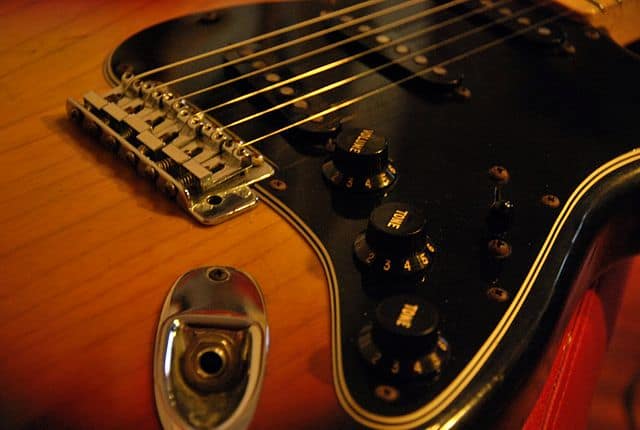Stratocasters are iconic guitars, played by legends like Eric Clapton and Jimi Hendrix.
In addition, Strats present a floating tremolo system, perfect to reach wonderful vibratos and dive bombs but this particular system has been modified on many occasions.
What players tend to do is block their strat tremolo, Clapton did it and many current players have also done it.
You may wonder how can you do this upgrade to your guitar but don’t be afraid, we are here to help you.
To block your strat tremolo system you will need some hardwood pieces, hand tools, and patience. What you have to do is set the angle of your vibrato, install the wood to fix it, and tighten the entire tailpiece to make it stay in place and disable the whole floating tremolo bar system.
Blocking a tremolo could bring major advantages to your instrument and in this article, we will cover each of them.
If you want to do this task or even know a bit more about this interesting topic you are in the right place!
Why would you want to block the tremolo of your Strat?
Stratocasters usually come with a floating tremolo style and even though is acceptable for the majority of guitar players, it brings some drawbacks.
Therefore, you can block the tremolo of your strat; that way you can go down in pitch but not up and it will bring noticeable points in favor.
To begin with, by blocking the tremolo you will have a better intonation in your instrument.
When blocking the tremolo system you are limiting the range of movement at the time of taking the whammy arm.
The bar will only tilt forward, contrary to a floating trem which can be moved back and forth.
As you will be applying fewer tension changes, the strings could keep in tune easily when doing dive bombs.
What is more, this modification adds more sustain to your tone.
Since the system is in contact with the guitar body, the vibrations can be transferred more straightforwardly, providing higher sustain.
In addition, a blocked tremolo will bring advantages for those who enjoy alternating among different tunings.
As the tremolo won’t be floating, retuning the strings will be an easier task.
Another interesting aspect is that if a string breaks, the guitar tends to stay in tune. What is more, due to your instrument will keep the tune easily, strings will be easier to replace.
How do you block the tremolo of a Strat?
After everything I mentioned, you may want to know how to perform this useful task and as we want to help you, we’ll explain how to block your vibrato.
Although you might think is a tough job, it is quite an easy procedure to follow so you could do it on your own.
Different players will employ their personal techniques to block the tremolo tailpiece and that’s acceptable.
However, we will show the two most common ways to do it, both known to be the best.
The first way to block the tremolo of a Stratocaster is simple.
It consists of adding shims or pieces of wood to the tremolo system to block it.
To do that you need to place these wooden pieces in the upper and lower cavities found at the back of the guitar’s body.
By doing that, every part will be stuck and the tremolo will be fixed, avoiding unwanted movements.
The goal of this procedure is to properly fix the entire system so apart from placing the shims, you can consider more options.
Therefore, it is important to have at least three (the more, the better) springs attached to the spring claw, which will reinforce the pieces, and everything it’ll be more rigid.
An issue to bear in mind is the type of wood you use to block the tremolo, you should avoid soft wood like pine.
Consider using a hardwood piece like maple, which works really well for this procedure, and make sure the piece has a snug fit.
The second method is the perfect option for those who do not want to deal with wood blocks.
In this case, you have to tighten the screws of the spring claw plate in a way that keeps it flush against the body.
If you apply this technique, is important to have the five springs attached to the spring claw plate and tremolo system.
The tension exerted by the springs will be enough to keep the vibrato blocked.
One remarkable aspect to consider when doing this task is to detune the strings of your guitar.
Since you will be doing notorious tension changes, is important to have the strings loosened.
What tools do you need to block a tremolo?
Blocking a tremolo is not as hard as thought, you could do it by yourself.
However, is not a task you can do with your bare hands, you require some tools but don’t worry, they are simply home tools.
First of all, you will need a ruler or any measuring tool.
If you have a caliper at home is the best option but you can use a steel ruler or metric tape.
Then, the hardwood pieces might not fit the slots so you will also require any tool to cut and adjust them.
A coping saw, a hand saw, or a jigsaw work perfectly to cut them but some sandpaper will be needed to eliminate rough edges.
If you go with the shims, you will need to get the pieces stuck altogether.
To do that, the best option is always wood glue.
Although it seems obvious, you need to unfasten and tighten the bolts somehow.
Get a screwdriver that fits the screws or you can use a hand drill if you have one at home.
Last but not least, safety is important when doing this kind of job.
Go get a pair of good gloves and if you use power tools when sanding or cutting, I recommend using safety glasses.
How to block a strat tremolo step by step
As we previously explained, blocking a strat tailpiece is not an impossible thing to do.
If you don’t feel capable of doing it, you can always visit a tech but if you manage to work on your instrument here you have how it’s done:
1. Remove the cover
As a strat player, you may know that there’s a plastic cover on the back of the guitar. You have to simply take off the six screws and remove the cavity cover.
2. Set the angle
Decide what inclination you want in your vibrato, you can choose if you prefer a tilted back, tilted forward, or parallel tremolo.
Once you set the wanted angle, loosen or tighten the strings to put the tremolo in the desired position when resting.
3. Measure the lower cavity
When the setting is already done, it is time to measure the gaps.
Turn back your instrument and with a measuring tool calculate the distance of the lower cavity.
4. Adjust and install the hardwood piece
Take a piece of wood (shims, maple, or any hardwood) and cut it to the width of the cavity.
Check the measurements and sand the block until you get the thickness you measured before.
Once you get the proper dimensions it’s time to install the block. You can slightly glue the block, it will help you hold it in place.
5. Measure and adjust the upper cavity
In the same way, you measured the slot at the bottom, you have to measure the upper cavity. Take your ruler, metric tape, or caliper and do it.
Repeat the process done before and sand the block to the desired thickness.
Bear in mind that in this cavity the tremolo system also has springs so you will need to shave the wedge to avoid any interference with them.
6. Install the hardwood piece
This cavity brings more difficulties than the previous one.
To install the block you will have to loosen the strings and remove the springs.
Once you do that you can install the wedge freely.
Again, a bit of glue will be helpful to stick it all together.
Now you can attach the springs back and fasten the screws of the spring claw. This is important to add some pressure to the block.
7. Re-intonation
When installing everything it is time to re-tune your guitar and adjust the intonation.
It could take you some time to get the suitable tuning but no more than five or ten minutes.
8. Noodle and check
You are reaching the end of the procedure but you need to know if everything is in the right place.
Take your guitar and noodle for a while, and try to do some dive bombs to check the blocking is done correctly.
If you feel is not perfectly blocked, leave the guitar some time to adjust to the new tension, you can also tighten or loosen the spring claw screws.
If you feel that the guitar keeps in tune, you are done! Congratulations, you did a wonderful job!
Optional: Install the tremolo cover
Most strat players tend to leave their guitars without the cavity cover.
Many musicians claim that is just because it looks cool, but some others affirm that by removing the cover the sympathetic resonance is reduced.
However, this is always up to the player’s preferences. You can either install your tremolo cavity cover back or leave your instrument without it.
Is a blocked tremolo Strat the same as a hardtail?
Contrary to what most people believe, a blocked tremolo is not the same as a hardtail.
These two terms usually confuse players making them think that have similar performances but that’s not the case.
In the first place, we have blocked tremolos, which is what we have covered throughout the whole article.
As its name evokes, blocking a tremolo is a process that comprises fixing the entire vibrato tailpiece to reduce the whammy arm available movements and gain sustain.
On the other hand, “hardtail” refers to a guitar design that doesn’t have a vibrato tailpiece.
In this manufacture, the bridge is stuck to the body plus it doesn’t present a tremolo arm, as it is fixed, there are no moving options.
This construction was invented during the 50s and today there are still many guitar models that are built with hardtail bridges.
Gibson guitar models mainly used this system and some Fender’s too, being Telecaster one of the most famous.

Hello there, my name is Ramiro and I’ve been playing guitar for almost 20 years. I’m obsessed with everything gear-related and I thought it might be worth sharing it. From guitars, pedals, amps, and synths to studio gear and production tips, I hope you find what I post here useful, and I’ll try my best to keep it entertaining also.





